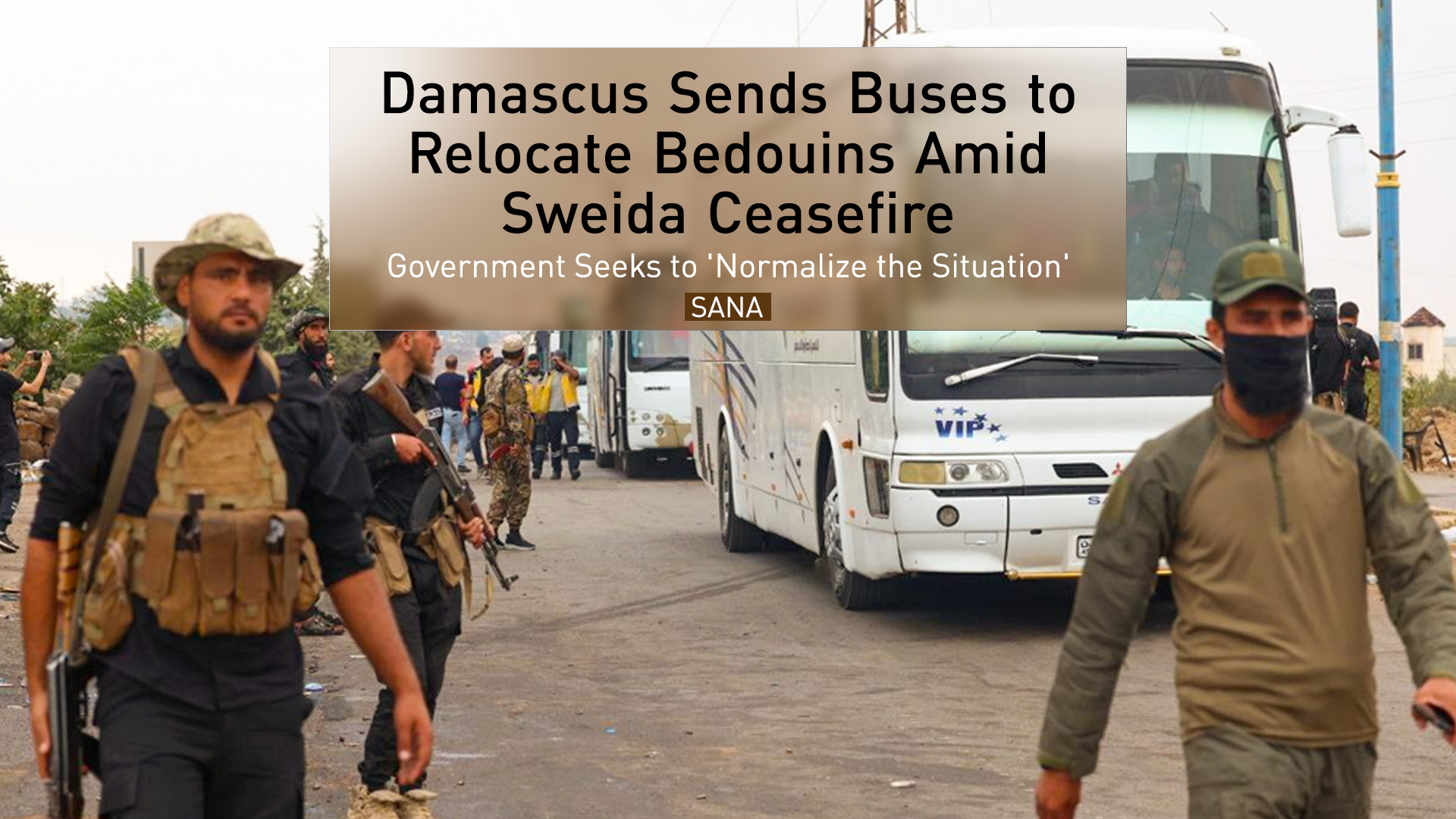Damascus Moves to De-Escalate Sweida Violence, Transports Bedouins
The Syrian gov't is moving Bedouins from Sweida after a ceasefire ended brutal clashes that killed over 1,000 people. The move comes amid international pressure and demands from Druze leaders for the army's complete withdrawal from the province.

By Kamaran Aziz
ERBIL (Kurdistan 24) – In a move aimed at de-escalating a week of ferocious sectarian violence that has reportedly left more than 1,000 people dead in southern Syria, the Syrian government has sent buses to Sweida province to transport hundreds of Bedouin people following the declaration of a fragile ceasefire.
The action, reported by the official Syrian Arab News Agency (SANA), is part of Damascus's efforts to “normalize the situation” in the Druze-majority province after a catastrophic series of clashes involving Druze fighters, Bedouin tribes, government forces, and Israeli airstrikes.
According to SANA, the Syrian government dispatched the vehicles to transport 1,500 members of Bedouin tribes after a ceasefire was announced at dawn last Saturday. The Syrian presidency had called on all parties to adhere to the agreement, warning of accountability for any violations.
Ahmad Dalati, the commander of the Internal Security Forces in Sweida, confirmed the government’s role in the de-escalation. As reported by SANA, Dalati stated that the Bedouin families who were detained in the province would be released within hours. He stressed that "the safe return of these families to their homes is guaranteed, as part of the state's commitment to protecting all citizens and preserving national unity."
Dalati also emphasized that all parties are now committed to the ceasefire and must "allow state institutions to play their role in restoring security and stability to the province."
The government's intervention follows a devastating period of bloodshed. The UK-based Syrian Observatory for Human Rights (SOHR) has published staggering casualty figures, indicating that the week-long violence claimed the lives of over 1,000 people.
According to the war monitor, the dead include 427 Druze fighters and 298 Druze civilians. In a harrowing detail, SOHR reported that 194 of these civilians were allegedly executed by personnel from the Syrian Ministries of Defense and Interior.
Government forces also suffered heavy losses, with SOHR reporting that 354 members of government security forces were killed in the clashes. An additional 15 government soldiers were reportedly killed by Israeli airstrikes during the turmoil. On the other side of the conflict, 21 Bedouins were reported killed.
The humanitarian toll was further underscored on Sunday, when Syrian Civil Defense teams transported 73 civilians, mostly women and children, from Sweida to the Damascus area, according to SANA.
The violence has drawn sharp condemnation from the international community, including from members of the U.S. Congress. On Sunday, U.S. Congressman Abraham J. Hamadeh issued a forceful statement denouncing the “barbaric violence against the Druze community in Syria,” calling for immediate action from Damascus.
“Now is the time for the Syrian government to turn their words into real actions—if they want to maintain legitimacy: restore order, protect all of its citizens, and demonstrate a genuine commitment to peace and long-term stability,” Hamadeh stated in a post on X. He added that a peaceful future requires “a new Syria that is reflective of its ethnic and religious mosaic.”
The ceasefire itself was confirmed by U.S. Special Envoy for Syria, Tom Barrack, who stated on Sunday that as of 17:00 local time, all parties “have navigated to a pause and cessation of hostilities.” He stressed that the next phase must include a full exchange of hostages and detainees, noting that the logistics for such an exchange were "in process."
However, local trust in Damascus remains low. The Druze spiritual leadership issued a strongly worded statement demanding the immediate withdrawal of all Damascus-affiliated forces—including the Syrian Army and intelligence units—from the entire Sweida region. Citing the “horrific massacres” committed against civilians, the leadership called for an immediate prisoner exchange to be carried out in the central square of Umm al-Zaytoun village under the watch of international sponsors.
The crisis in Sweida is not an isolated event but reflects a pattern of deepening sectarian rifts and state-led violence across Syria. It comes as the Syrian Presidency announced it had received the final report from a national fact-finding committee investigating a wave of sectarian violence in the country’s coastal region in March.
That separate incident involved armed loyalists of former President Bashar al-Assad allegedly orchestrating attacks, which were followed by what SOHR described as grave violations, including massacres and summary executions by government forces and allied militias that killed approximately 1,700 civilians, most of them Alawites. The Syrian Presidency has pledged to review the coastal report’s findings “with the utmost care” to ensure “truth, justice, accountability, and the prevention of such violations.”
As the buses begin to move people out of Sweida, the Syrian government faces immense pressure to prove it can protect its minorities and hold perpetrators of violence accountable, with both domestic and international actors watching closely to see if its promises of stability and justice will be translated into meaningful action.
